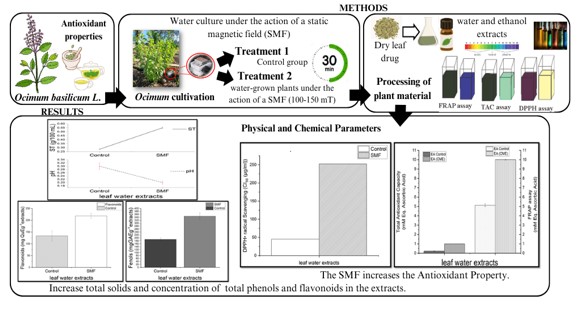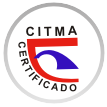QUALITY OF EXTRACTS FROM Ocimum basilicum L. LEAVES GROWN WITH MAGNETICALLY TREATED WATER
Keywords:
basil; static magnetic field; DPPH; phenols and flavonoidsAbstract
Ocimum basilicum L. (sweet basil) is recognized for its health-promoting properties,
mainly for its antioxidant activity. Magnetically treated water (MTW) irrigation technology
contributes to the improvement of plant production. The organoleptic characteristics, pH,
total solids, chemical parameters and antioxidant property of dry leaf extracts of O.
basilicum L. cultivated with a static magnetic field were evaluated. Two experimental
groups were formed: control and plants grown with MTW (100-150 mT). A higher
concentration of metabolites and antioxidant property was demonstrated for the water
extract. However, a greater influence of the magnetic field on free radical scavenging
activity values was observed for the ethanol extract. MTW stimulated the quality
parameters and antioxidant property of the extracts. Irrigation with MTW could be
considered a promising technology in improving is vegetal spices crop yield.
References
FARÍAS, C. et al. “Albahaca: composición química
y sus beneficios en salud”. Revista Chilena de
Nutrición, 2022, 49(4), 502-512.
http://dx.doi.org/10.4067/S0717-75182022000500502
DURÁN GAVIRIA, L. A. et al. “Calidad
fisiológica de semillas de cinco variedades de
Albahaca Ocimum spp. en condiciones del Valle del
Cauca”. Acta Agronómica, 2016, 65(1), 38-43.
https://doi.org/10.15446/acag.v65n1.45377
ACEVEDO RODRÍGUEZ, P.; STRONG, M. T.
Catalogue of seed plants of the West Indies. edited by
S.I.S. PRESS. Edition ed. Washington DC., 2012.
ISBN 0081-024X; 1938-
https://doi.org/10.5479/si.0081024X.98.1
REZZOUG, M. et al. “Chemical composition and
bioactivity of essential oils and Ethanolic extracts of
Ocimum basilicum L. and Thymus algeriensis Boiss.
& Reut. from the Algerian Saharan”. Atlas. BMC Complementary and Alternative Medicine, 2019, 19,
-10. https://doi.org/10.1186/s12906-019-2556-y
AÇıKGÖZ, M. A. “Effects of sorbitol on the
production of phenolic compounds and terpenoids in
the cell suspension cultures of Ocimum basilicum L.”
Biologia, 2021, 76(1), 395-409.
https://doi.org/10.2478/s11756-020-00581-0
LORAINE, S.; MENDOZA ESPINOZA, J. A. “Las
plantas medicinales en la lucha contra el cáncer,
relevancia para México”. Revista Mexicana de
Ciencias Farmacéuticas, 2010, 41(4), 18-27.
Available from World Wide
Web:<https://www.redalyc.org/pdf/579/57916060003
.pdf>
MAHENDRA, M. Y. et al. “Estragole: A review of
its pharmacology, effect on animal health and
performance, toxicology, and market regulatory
issues”. Iraqi Journal of Veterinary Sciences, 2023,
(2), 537-546.
https://doi.org/10.33899/ijvs.2022.135092.2445
GARCÍA DÍAZ, J. et al. “Caracterización
etnobotánica de plantas medicinales en dos
comunidades de la Región Suroriental de Cuba”.
Caldasia, 2023, 45(2), 23-34.
https://doi.org/10.15446/caldasia.v45n2.95613.
HEREDIA-DÍAZ, Y. et al. “Estudio etnobotánico
de las plantas medicinales usadas por los habitantes de
Holguín, Región Oriental, Cuba”. Boletín
Latinoamericano y del Caribe de Plantas Medicinales
y Aromáticas, 2018, 17(2), 160-196. Available from
World Wide Web:<https://www.blacpma.mseditions.cl/index.php/blacpma/article/view/41/35>
ARZOLA, D. C. Formulario Nacional de
Fitofármacos y Apifármacos. Edtion ed. La Habana,
ISBN 978-959-212-902-3. Available from
World Wide
Web:<http://www.bvscuba.sld.cu/libro/formularionacional-de-fitofarmacos-y-apifarmacos-segundaedicion/>. Fecha de revisión: 20 agosto de 2022.
SESTILI, P. et al. “The potential effects of
Ocimum basilicum on health: a review of
pharmacological and toxicological studies”. Expert
Opinion on Drug Metabolism & Toxicology, 2018,
(7), 679-692.
https://doi.org/10.1080/17425255.2018.1484450
TÜRKMEN, M. “The effect of different
Phenological periods and harvest times on the
essential oil ratio and components of basil genotypes”.
Journal of Essential Oil Bearing Plants, 2021, 24(1),
-109.
https://doi.org/10.1080/0972060X.2021.1894243
BERMÚDEZ DEL SOL, A. et al. “Uso
tradicional de las plantas medicinales por la población
del municipio de Santa Clara, Cuba”. Journal of
Pharmacy Pharmacognosy Research, 2018, 6(5), 374-
Available from World Wide
Web:<http://jppres.com/jppres>
NYAKANE, N. E. et al. “The effects of magnetic
fields on plants growth: a comprehensive review”.
International Journal of food engineering, 2019, 5(1),
-87. https://doi.org/10.18178/ijfe.5.1.79-87
ALVARADO, K. et al. “Efecto del agua
magnetizada en algunos parámetros morfológicos de
las especies romero (Rosmarinus officinalis) y llantén
menor (Plantago lanceolata)”. Centro Agrícola, 2012,
(3), 81-86. Available from World Wide
Web:<http://cagricola.uclv.edu.cu/descargas/pdf/V39-
Numero_3/cag143121871.pdf>
FUNG-BOIX, Y. et al. “Assessment of the
Antioxidative Potential of Rosmarinus officinalis
L.(Lamiaceae) Irrigated with Static Magnetic FieldTreated Water”. Brazilian Archives of Biology
Technology, 2020, 63, 45-53.
http://dx.doi.org/10.1590/1678-4324-2020190142
RODRÍGUEZ FERREIRO, O. A. et al.
“Parámetros físicos, físicos-químicos y químicos de
extractos de Origanum majorana L. cultivado
utilizando agua magnetizada”. Revista Cubana de
Química, 2018, 30(3), 454-469. Available from World
Wide Web:
<http://scielo.sld.cu/scielo.php?script=sciarttext&pid=
S2224-54212018000300007&lng=es&nrm=iso.
GILART, F. et al. “High flow capacity devices for
anti-scale magnetic treatment of water”. Chemical
Engineering Processing: Process Intensification,
, 70, 211-216.
https://doi.org/10.1016/j.cep.2013.04.001
Agexport Agrícola. Albahaca, Ocimum basilicum
[;online];. [;Guatemala];: 2024;revisado enero 2024.
Available from World Wide
Web:<https://www.export.com.gt/documentos/guiade-cultivos/guia-de-cultivo-de-albahaca.pdf>
ALBAYRAK, S. et al. “In vitro antioxidant and
antimicrobial activity of some Lamiaceae species”.
Iranian Journal of Science and Technology
(Sciences), 2013, 37(1), 1-9. Available from World
Wide Web:<http://www.shirazu.ac.ir/en>
JAYASINGHE, C. et al. “Phenolics composition
and antioxidant activity of sweet basil (Ocimum
basilicum L.)”. Journal of agricultural food
chemistry, 2003, 51(15), 4442-4449.
https://doi.org/10.1021/jf034269o
PÉREZ PORTERO, Y. et al. “Estabilidad físicoquímica del extracto hidroetanólico al 70 % de hojas
de Spondias mombin L.” Revista Cubana de Química
, 2021, 33(3), 305-325. Available from World Wide
Web:<http://scielo.sld.cu/scielo.php?script=sci_arttext
&pid=S2224-
&lng=es&nrm=iso>
MINSAP. “Medicamentos de origen vegetal:
Extractos y Tinturas. Procesos tecnológicos”. Norma
Ramal de Salud Pública (NRSP 311). In.: La Habana.
Cuba, 1991.
MINSAP. “Medicamentos de origen vegetal: Extractos
y Tinturas. Métodos de ensayo”. Norma Ramal de Salud
Pública (NRSP 312). In. La Habana. Cuba, 1991.
KOSALEC, I. et al. “Quantitative analysis of the
flavonoids in raw propolis from northern Croatia”.
Acta pharmaceutica, 2004, 54(1), 65-72. Available
from World Wide
Web:<https://urn.nsk.hr/urn:nbn:hr:163:570058>
SHARMA, A. D. et al. “Comparative
phytochemistry, antioxidant, antidiabetic, and antiinflammatory activities of traditionally used Ocimum
basilicum L. Ocimum gratissimum L., and Ocimum
tenuiflorum L.” BioTechnologia, 2022, 103(2), 131.
https://doi.org/10.5114/bta.2022.116206
LOZANO-SUQUILANDA, G. M.; SOPALOACERO, A. J. Optimización del proceso de
extracción hidroalcohólica a partir del albahaca
(Ocimum basilicum) en función del contenido de
polifenoles y capacidad antioxidante. Ecuador:
Latacunga: Universidad Técnica de Cotopaxi (UTC),
Available from World Wide
Web:<http://repositorio.utc.edu.ec/handle/27000/8742
>. Revisión: Julio 2023.
SHARMA, K., et al. “Health effects, sources,
utilization and safety of tannins: A critical review”.
Toxin Reviews, 2021, 40(4), 432-444.
https://doi.org/10.1080/15569543.2019.1662813
CONTRERAS-PÉREZ, C. Z. Efecto biocida de
las hojas Ocimum basilicum (Albahaca) contra
Acanthoceslides obtectus (Say) gorgojo del grano
de pallar (Phaseolus lunathus) almacenado.
Universidad nacional San Luis Gonzaga, 2023.
Available from World Wide
Web:<https://hdl.handle.net/20.500.13028/4793>
SALTOS BRAVO, M. VÉLEZ ÁLAVA, P.
“Caracterización físico-química, microbiológica y
funcional de los extractos de la especie albahaca
morada (Ocimum sanctum)”. Revista Científica
INGENIAR: Ingeniería, Tecnología e Investigación,
, 2(4), 2-11.
https://doi.org/10.46296/ig.v2i4.0008
NADEEM, H. R., et al. “Toxicity, antioxidant
activity, and phytochemicals of basil (Ocimum
basilicum L.) leaves cultivated in Southern Punjab,
Pakistan”. Foods, 2022, 11(9), 1239.
https://doi.org/10.3390/foods11091239
GIL, M. I., et al. “Antioxidant capacities, phenolic
compounds, carotenoids, and vitamin C contents of
nectarine, peach, and plum cultivars from California”.
Journal of agricultural food chemistry , 2002, 50(17),
-4982. https://doi.org/10.1021/jf020136b
SALAS-PÉREZ, L., et al. “Composición
fitoquímica y actividad antioxidante en tres
variedades de albahaca por efecto de distintos
solventes”. Revista Mexicana de Ciencias Agrícolas,
, 13(SPE28), 113-123.
https://doi.org/10.29312/remexca.v13i28.3267
FAUR, A., et al. “Correlations on Phenolic
Screening Related to In Vitro and In Ovo
Assessment of Ocimum basilicum L. HydroAlcoholic Extracts Used as Skin Active Ingredient”.
Molecules, 2020, 25(22), 5442.
https://doi.org/10.3390/molecules25225442
QASEM, A., et al. “Determination of Chemical
Composition and Investigation of Biological
Activities of Ocimum basilicum L.” Molecules,
, 28(2), 614.

Downloads
Published
How to Cite
Issue
Section
License
Copyright (c) 2025 Cynthia Ramos-Frómeta, Yanaisy Pérez-Quintero, Javier Almenares-Rosales, Yilan Fung-Boix, Ania Ochoa-Pacheco

This work is licensed under a Creative Commons Attribution-NonCommercial-NoDerivatives 4.0 International License.
This journal provides immediate open access to its content, based on the principle that offering the public free access to research helps a greater global exchange of knowledge. Each author is responsible for the content of each of their articles.






















